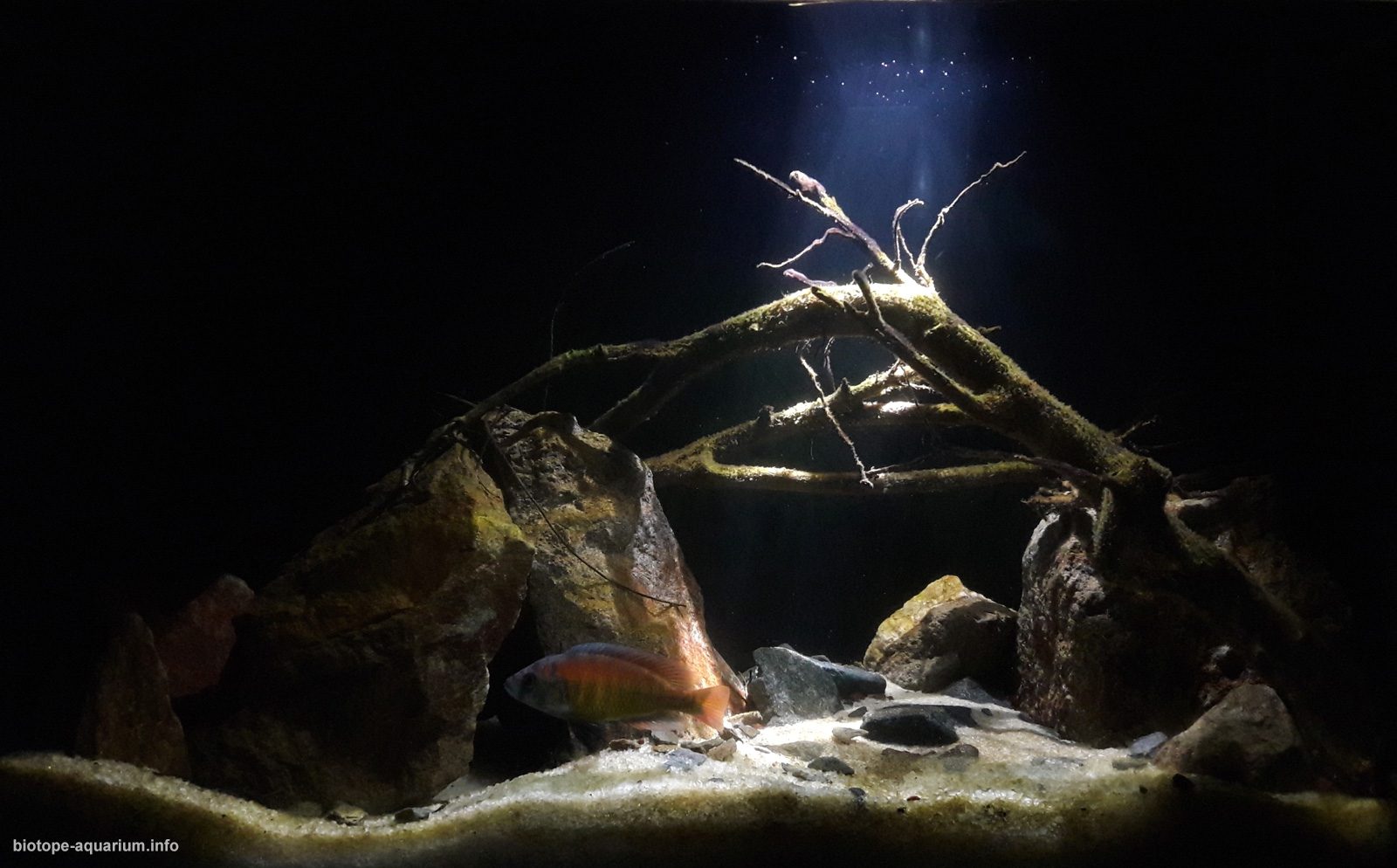Lake Victoria. Sublittoral areas of the Mwanza Bay. Tanzania
106th place in Biotope Aquarium Design Contest 2018
![]() Russia. Ivan Chaika
Russia. Ivan Chaika

Volume: 60 L
Dimensions: 65х42х22 cm
List of fishes: Haplochromis nyererei
List of plants: N/A
Description of decorations: The driftwood used in the design of the aquarium were found on the island of the River Don. These are the roots of fallen and dried ash. Its roots, after special treatment and soaking, do not stain water and are an excellent substrate for algae and bacteria, making the composition colorful and biotope-like. The basis of the composition is large sandstone pieces forming a cave and small shelters. The white quartz sand with grains of 1-3 mm brightens dark tones and is necessary for Haplochromis nyererei, since they build nests for spawning in it.
Description of equipment: Internal filter Fluval U3, 600 lph, LED lamp Chihiros A601, 8000K, 5800 lm
Water parameters: Temperature is 27°C, pH is 8.0, GH is 18
INFORMATION ABOUT BIOTOPE
Description of the area surrounding the biotope: Lake Victoria is a lake in East Africa, on the territory of Tanzania, Kenya and Uganda. It is located in the tectonic deflection of the East African platform, at an altitude of 1134 m. Its area is 68 thousand square km, the maximum depth is about 80 m, the volume is 8,400 cubic km. The length of the coastline is 7 thousand km. The length of the reservoir is 320 km, and its width is 240 km. It is the 2nd largest freshwater lake in the world after the Lake Superior and the largest lake in Africa by area. It is also the largest of tropical lakes. The British traveler John Hanning Speke discovered the lake and named it in honor of Queen Victoria in 1858. The basin of the Lake Victoria in Eastern Africa was formed as a result of the general elevation of the surrounding land. The lake is filled mainly by rains and the waters of numerous rivers flowing from the surrounding mountains. These are predominantly small watercourses. Among them only the deep-water Kagera River is remarkable, which is considered to be the source of the Nile.
Description of the underwater landscape of the biotope: The water level during the year fluctuates slightly, within 20-40 centimeters. However, the secular fluctuations of the water level reach 2-3 meters. Periodically, there are large increases in water levels, caused exclusively by abundant precipitation. In recent decades, there has been a tendency in this region to reduce the amount of precipitation. In recent years, a decrease in the water level of the lake by 1 meter has been noted. The strongest storm activity caused by hurricane winds during tropical thunderstorms on a vast (68,635 square km) open water space at a comparatively shallow depth provides good mixing of the layers and saturation of the water with oxygen. The bottom of the lake consists of sand and large stone boulders covered with algae, where small crustaceans live, for example Cyclopidae.
Description of the parameters of the habitat: In the Lake Victoria region, there are 2 rainy seasons a year: from March till May, and from October till December. April and May are especially rainy, in each of these months the lake receives 200-300 millimeters of moisture. Transparency of water in open areas reaches 8 meters (near the coast it is less); pH varies between 7.1 and 9.0. The average temperature of the lake is + 21°C. Conductivity of water is from 98 to 145 µS/cm (at a temperature of 20°C).
List of fishes and invertebrates occurring in the nature biotope: Haplochromis nyererei, Haplochromis brownae, Haplochromis nigricans, Haplochromis aeneocolor, Haplochromis bartoni, Haplochromis greenwoodi, Haplochromis rufocaudalis, Oreochromis esculentus, Оreochromis variabilis, Protopterus sp., Lates niloticus.
List of plants found in the nature biotope: In the biotope area, there are no underwater plants, except coastal zones and deltas, where Phragmites sp., Scirpus sp., Cyperus papyrus and Eichhornia crassipes grow.
Threats to the ecology: The ecology of the lake is in serious danger due to the intensive growth of the local population, the continuous deforestation of the entire coast, the overdeveloped fish export industry, adding exotic plants and animals, and as a result, the disappearance of more than 50% of local fish, hypertrophic algae growth and discharge of untreated waste water from enterprises and sewage water from coastal settlements. In order to increase the number of fish the Nile perch was released into the lake, which led to the extinction of many species of cichlids. Caused damage is huge and largely irreplaceable. The breeding and conservation of the Lake Victoria cichlids in an aquarium will save them for civilization. The naturalists agreed that if they did not take urgent measures to save the lake, it would die. In addition to eutrophication and an increasing discharge of sewage, Eichhornia crassipes is also responsible for intensive drying of the lake. This freshwater plant, distinguished by its extraordinary persistence and intensive reproduction, was brought to Africa in the early 20th century as a decorative plant. Since then it is intensively spreading. In the late 1990s, water hyacinths caused a sharp decline in the number of fish in Lake Victoria, as Eichhornia absorbs a significant amount of oxygen from the water. In addition, their roots and leaves block the tributaries and outflow of water from the lake. OSIENALA monitors the distribution of aquatic hyacinths and takes urgent measures when their number increases. Due to the drop in the water level in Lake Victoria, in early 2006 a representative of the UN’s International Strategy for Disaster Reduction reported that the Ugandan hydropower plant consumes more water from the lake than is provided for by the relevant international treaty, signed 50 years ago.
Sources of information:
http://advices4lady.org/373-
http://www.interesnie-fakty.
http://www.animals-wild.ru/
http://biofile.ru/geo/129.html
https://aquazoom.ru/neni/neni.
http://zoomix-opt.ru/ozero-
http://aquaria.ru/node/9382
http://www.
